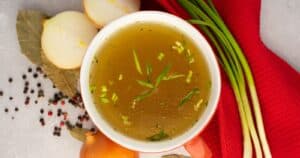Nothing’s worse than putting in all the prep work for hot pot only to end up tossing the leftover broth the next day. Between shopping for ingredients, slicing everything thinly, and finally gathering around the simmering pot, it’s a labor of love. But is it still safe to enjoy the rest of that tasty broth the next day?
The good news is that hot pot broth keeps longer than you might think when stored properly. While it may lose some freshness, broth can often last 3-5 days refrigerated. The ingredients you cook in the hot pot have a big impact. Factors like oil, acidity, and leftovers affect broth longevity. With some simple storage tactics, you can get the most out of your hot pot effort and enjoy the leftovers for days.
Read on to learn just how long hot pot broth stays safe and delicious. With a few careful storage tips, you can cut down on waste and keep the hot pot flavors going strong all week long. Soon you’ll be a master at planning the perfect amount of broth so none goes to waste.
How Long Does Hot Pot Broth Last Refrigerated?
Assuming proper storage, here are the typical shelf lives for different types of refrigerated hot pot broth:
- Clear broth – 5-7 days
- Seafood broth – 3-4 days
- Spicy broth with oil – 3-5 days
- Tom yum broth – 3-4 days
- Broth with leftovers – 1-2 days
The more simple the broth, the longer it will keep. Seafood, acidic ingredients like tomatoes, and leftover bits shorten shelf life.
Always rely on your senses too. If the broth smells, looks, or tastes off, toss it regardless of how long it’s been.
Storing Hot Pot Broth for Maximum Freshness
To get the longest shelf life from your leftover broth, follow these storage tips:
- Let broth fully cool before refrigerating.
- Divide into smaller containers to allow quick cooling.
- Cover containers tightly.
- Use shallow containers so broth cools in a thin layer.
- Refrigerate broth within 1 hour of cooking.
- Don’t keep broth above 40°F for over 2 hours total.
- Label containers with dates.
- Store furthest back on refrigerator shelves.
Proper hot and cold holding temperatures prevent bacteria growth.
What Makes Hot Pot Broth Go Bad Faster?
Several ingredients and factors can shorten the shelf life of hot pot broth:
Seafood – Fish, shellfish, etc. contain bacteria that multiply quickly.
Oil – Fats can go rancid faster than water-based broth.
Acidity – Vinegar, tomatoes, citrus, etc. allow microbial growth.
Dairy – Milk proteins spoil quicker than meat/veg proteins.
Starchy noodles – Noodles leach starch and nutrients bacteria feed on.
Leftover bits – Cooked meat and veggies accelerate spoilage.
Frequent temperature changes – Repeated cooling/reheating shortens freshness.
Contamination – Shared utensils can introduce new bacteria.
Excess broth – Larger volumes take longer to chill, so bacteria multiply first.
For maximum shelf life, avoid these high risk ingredients when possible.
Can You Freeze Hot Pot Broth?
Freezing is a great way to preserve hot pot broth for longer storage. Most broths stay fresh in the freezer for 2-3 months.
To freeze broth:
- Let cool completely first.
- Portion into ice cube trays or small containers.
- Leave 1⁄2 inch room at the top for expansion.
- Seal tightly.
- Label with name and date.
- Freeze for up to 3 months.
Thaw overnight in the fridge before reheating. Add a splash of fresh broth or water if thicker after freezing.
Tips for Freezing Broth
- Double wrap glass containers to prevent cracking.
- Use plastic containers meant for freezing to avoid leaks.
- Lay flat in freezer to freeze faster.
- Freeze within 1-2 days of making for best quality.
- Only freeze clear broths. Dairy, seafood, or oil-based broths don’t freeze well.
With proper freezing techniques, you can enjoy your favorite hot pot broths for months rather than days!
How to Tell if Leftover Broth Has Gone Bad
Trust your senses to know if hot pot broth has spoiled:
Sight
- Cloudiness
- Changes color
- Mold/sliminess
Smell
- Sour odor
- Rotten smell
- Ammonia-like
Texture
- Extremely thick
- Foam/bubbles
- Gelatinous globs
Taste
- Tangy, sour
- Bitter
- Metallic
When in doubt, throw it out! Even if broth looks okay but smells or tastes funky, don’t risk getting sick.
Food Safety Tips for Handling Hot Pot Broth
Follow these food safety guidelines when storing and reheating hot pot broth:
- Never leave broth or cooked ingredients at room temp for over 2 hours.
- Quickly refrigerate leftovers in smaller, shallow containers.
- Only reheat broth once. Repeated reheating increases bacteria.
- Bring broth to a full rolling boil when reheating.
- Don’t use reheated broth for dipping raw meats/seafood.
- Don’t add fresh ingredients to old broth. Use new broth.
- Discard old broth if you are sick or have a weakened immune system. Don’t risk it!
Being diligent about temperatures and storage helps keep hot pot leftovers safe.
Frequently Asked Questions About Hot Pot Shelf Life
Can you reuse hot pot broth?
It’s not recommended to reuse hot pot broth for food safety reasons. Always start with fresh broth.
Does adding lemon juice help preserve broth?
No, lemon actually shortens shelf life due to acidity. Stick to clear, neutral broths for longest longevity.
How long does unopened hot pot broth last in the pantry?
Commercially sealed, shelf-stable hot pot broths last 6-12 months in the pantry before opening.
Is it safe to eat hot pot broth that smells funny but tastes okay?
No, never eat broth that smells spoiled or rancid, even if the taste seems fine. Odors indicate bacteria growth.
Can you use reheated hot pot broth for dipping raw foods?
It’s not advised. Reheated broth has higher bacterial levels and risks contaminating raw ingredients. Use fresh broth only.
Get the Most from Your Hot Pot with Proper Storage
One of the joys of hot pot is the complex, flavorful broth left behind. With careful storage and handling, you can enjoy every last drop for up to a week after cooking. Keep broth refrigerated in small containers, and freeze excess for later.
Trust your senses – if broth seems at all off, don’t take chances. Follow basic food safety rules when reheating and serving. With some simple precautions, you can avoid waste and delight in hot pot leftovers for many meals to come. Here’s to enjoying the fruits of your hot pot labor to the very last drop!





